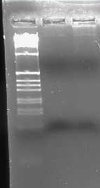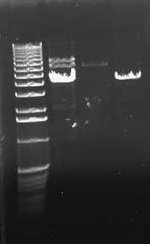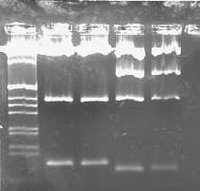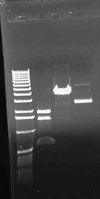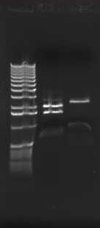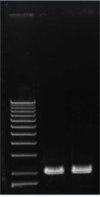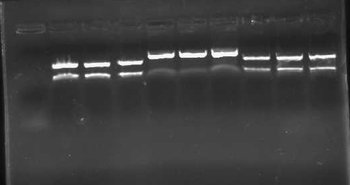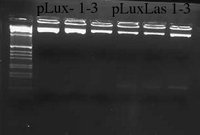Will Notebook1
Wideloache 14:06, 19 December 2008 (EST)
Today I ran the O/N digestions of pSB1A2-pLux' and pSB1A2-pLuxLas on a gel:
There was no DNA in either of the wells. This suggested that whatever I grew up from the transformation plate was not a successful ligation product. Possibly it was contamination due to bad plates (I have been getting lots of satellite colonies on these new Amp plates. Perhaps the Amp concentration is too low???). I will have to begin next semester by moving pLux and pLuxLas into pSB1A2 with an EcoRI/PstI digest of the plasmid sent from GeneArt.
I also froze down all of the cells that I grew up last night. The pSB1A2-K091206 culture didn't grow. I will have to freeze that part down when I return. For the rest of the parts, I put them in the following locations in the -80 (Box 4-1):
pSB1A2-K091204 = 42
pSB1A2-K091205 = 43
J61002-J23100 = 51
pSB1A2-S03954 = 40
pSB1A2-I0462 = 41
pSB1A2-B0015 = 30
HB101 +pInt80-649 = 52
Ec100D::pir+ +pG80ko-stufferInsert = 55
Ec100D::pir+ +pG80ko-K091206 = 53
LacIX86-pLux' = 45
LacII12X86-pLuxLas = 44
Ec100D::pir+ = 54
All of these locations were entered into online database.
To do's when I get back from the break: Move pLux and pLuxLas into pSB1A2. Put all 4 promoters in front of GFP. Complete the genomic insertion. Try different growth conditions at 43C to see if I can get the final step of the procedure to work. Make new genR plates.
Wideloache 16:51, 18 December 2008 (EST)
Done with exams finally!
The HB101 +pInt80-649 +pG80ko-K091206 cells that had grown up at room temp after a night at 43 did not show any grown in liquid culture at 43C. I will let them go one more night, but I'm not very hopeful that they will grow.
I also didn't have growth for pLux'-2 and pLuxLas-2 colonies that I had picked yesterday from their transformation plate. It appears that when I streaked onto the LB+Amp plates I lost all of the cells for both of those colonies because I did have growth on the plates (but there was no growth at the end of the streaks). I miniprepped pLux'-1 and pLuxLas-1 and digested them (5uL) with EcoRI and PstI. I will run them on a gel tomorrow to see if they are correct.
I picked colonies from the following plates for O/N growth in the respective antibiotics + LB. I will freeze these cells down tomorrow and enter them into the database:
Ampicillin:
pSB1A2-K091204
pSB1A2-K091205
J61002-J23100
pSB1A2-S03954
pSB1A2-I0462
pSB1A2-B0015
pSB1A2-pLux-1 (The second colony didn't grow, see above)
pSB1A2-pLuxLas-1 (The second colony didn't grow)
pSB1A2-K091206
HB101 +pInt80-649
Gentamicin:
Ec100D::pir+ +pG80ko-stufferInsert
Ec100D::pir+ +pG80ko-K091206
Kanamycin:
LacIX86-pLux'
LacII12X86-pLuxLas
LB:
Ec100D::pir+
Wideloache 23:30, 17 December 2008 (EST)
I was really busy with exams over the past few days. Today I turned in my independent study paper and had some time to get some things done in lab:
I transformed the following parts into JM109 cells (Zyppy transformation):
pSB1A2-K091204
pSB1A2-K091205
J61002-J23100
pSB1A2-S03954
pSB1A2-I0462
pSB1A2-B0015
I had been meaning to freeze these constructs down for a while, but I hadn't gotten around to it. Tomorrow I will pick a colony from each plate for O/N growth and freeze them down on Friday.
Today I also froze down some HB101 +pInt80-649 +pG80ko-K091206 cells. These cells had been grown up in LB+Gen at 30C. I put the tubes in the freezer data base, but in case it goes down, they are in box 4-1 in cells 46 and 56.
I grew up two colonies from the pLux' and pLuxLas transformation plates from a couple of days ago. I also streaked these colonies on LB+Amp. I will miniprep them tomorrow and digest to verify a successful transfer into pSB1A2.
Finally, I saw that a lot of cells had come up on the HB101 +pInt80-649 +pG80ko-K091206 plate that I had grown at 43C after squirting 50 uL of cells on it. I doubt that these cells have undergone genomic insertion, but just to make sure, I picked one of them and grew it up in LB+Gen at 43C. If the culture grows, I will do a PCR screen with the 4 verification plasmids to see if I do indeed have a successful genomic insertion.
Wideloache 13:30, 11 December 2008 (EST)
Yesterday I miniprepped the cultures from the LB+Kan plates (LacIX86-pLux' and LacII12X86-pLuxLas). I digested these plasmids with EcoRI and PstI (5uL of DNA each). Today I will run these on a 2.0% gel to verify that they are correct. If they are, I will excise the ~100 bp band and ligate with pSB1A2 (with RFP cut out).
Pallavi and I also digested the DNA that had been given to us by GeneArt with EcoRI (20 uL reaction volumes). We ran these digestions next to the digestion of the 2 minipreps. This helped with verification of the samples sent by GeneArt.
Finally, I ran an O/N digestion of pG80ko-K091206, pInt80-649, and the miniprep of the HB101 cells that should have both plasmids in them. I will run these on a .4% gel today. This will tell me if the HB101 cells did indeed have both plasmids and were just slow growers.
Expected lengths for the two plasmids were: pInt80-649 = 6335bp. pG80ko-K091206 = 4268bp. Both plamids appear to be in the miniprep sample, although other bands are present at 2000bp and possibly at 1000. There is also a band that is larger than expected above pInt80-649.
The digestion of the two synthesized parts was successful. The plasmid from GeneArt and the plasmid from the miniprep appeared to be the same. Because the miniprepped plasmid had been cut with PstI as well as EcoRI, the vector had been cut in half and my two promoter parts were a little shorter. I excised these two shorter bands and ligated into pSB1A2.
Wideloache 17:24, 9 December 2008 (EST)
I had growth on both the Amp and the Kan plates. Dr. Campbell had gotten in touch with the GeneArt people, who said that both of the plasmids were supposed to be Kan resistant (the difference in cap color was a mistake). There were only a few colonies on each of the Kan plates (but I had forgotten to rescue the cells when I did the transformation). There were more colonies on the Amp plates with significant satellite colonies after only 20 hours of growth.
I grew up to Kan colonies O/N to verify tomorrow.
Wideloache 14:53, 8 December 2008 (EST)
I let the cells grow for two nights since they were slow growers. On Sunday I came in and found that there was growth (although minimal growth) on the LB+Gen plate at 30C and no growth on the LB+Gen plate at 43C. I plated 50uL of the HB101+2 integration plasmids on an LB+Gen plate (43C) to see if maybe I didn't have enough cells when I streaked last time. I also grew up some liquid culture O/N for miniprepping today. There was no growth on that plate this morning. I miniprepped the cells and will digest them with EcoRI before running them on a gel (with 2 controls).
It is possible that the Gen concentration (20ug/uL) is too high on the plates. I will reduce to 15 (ug/uL) which is what Chris said to use. It is possible that the low copy on the genome means that the cells can't grow once the insertion has occurred.
The promoters from GeneArt arrived today as well. As instructed, I resuspended each tube in 50uL of water and allowed to sit for 1 hour. At that point I pipetted up and down and then transformed into JM109 to prepare a cell stock.
From the documentation on the CD that came with the DNA, it appears that the promoters are on a Kan resistant plasmid. However, one of the tubes has a red top which is supposed to indicate Amp resistance. I plated on both Kan and Amp.
Wideloache 13:40, 5 December 2008 (EST)
Great news today!
Firstly, I began to see colonies on my transformation plate of HB101+pInt80-649 + pG80ko-K091206 from 12/02/08. I had left them on the bench top since 12/03/08. This supported the evidence from yesterday that the doubly transformed cells were slow growers.
Secondly, I had growth on the LB+Amp plates with HB101+pInt80-649 when grown at 30C and 37C. I had no growth in the plate at 47C. (It should be noted that I streaked two colonies on each plate. When I did the streaking I went 30->37->43 for one colony and 43->37->30 for the other. The colony that was streaked on the 30C plate last did not grow, probably because I had run out of cells by the time I streaked on that plate.) This confirmed that the plasmid was temperature sensitive and that it was likely I had the right plasmid in my possession.
Thirdly, the colonies from the LB+gen plate (11/24/08) grew up in LB+Gen culture. I grew two colonies (one big, one small) at 37 and two colonies (one big, one small) at 30. The 30C culture grew to saturation O/N. The 37C cultures grew much slower, but evidence of growth was still there.
Finally, the DNA for the pLux' and pLuxLas promoters was shipped today from Germany. It should arrive on Monday.
I streaked each of the 2 cultures from the 30C incubation onto two LB+Gen plates. One plate was put at 30C (control) and one was put at 43C to get rid of pInt80-649.
Wideloache 14:30, 4 December 2008 (EST)
Oops. I forgot to make entries over the last couple of days. To summarize: On Monday (12/1/08) night I picked a colony of HB101+pInt80-649 from the plate in the fridge. I grew it up O/N in LB+Amp. On Tuesday (12/2/08) I transformed in pG80ko-K091206 using the competent cell procedure. I also transformed some of the cells with pSB1AK3-B0015 as a positive control for transformation. I rescued at 30C (which I hadn't done last time) and I grew them up on LB+Gen (pG80ko-K091206) and LB+Kan (pSB1AK3-B0015) at 30C. On Wednesday (12/03/08) I found that there were colonies on the Kan transformation, but that there were none on the Gen plate. No growth was seen on either of the control plates for contamination (no DNA added).
Since the transformation of pG80ko-K091206 has failed three times, I am going to have to do more thorough trouble shooting. I will try 3 different things:
1) Streak a colony of HB101+pInt80-649 onto three LB+Amp plates. I will grow one at 43C, one at 37C, and one at 30C. This will test to make sure that the Amp resistant plasmid in the HB101 cells is temperature sensitive (I would expect the cells at 43C to not grow).
2) Miniprep HB101+pInt80ko cells and perform a multiple digestion of pInt80ko to make sure that the DNA cuts where I would expect it to.
3) Possibly try the transformation on an LB+Amp+Gen plate.
As I was preparing to do these experiments, I found that the LB+Gen plate from 11/24/08 had bacterial colonies on it (with one fungal colony in the middle). It was possible that these cells just took a long time to grow up, so I picked two small colonies and two big colonies and put them in LB+Gen culture. I grew two tubes at 37C and two tubes at 30C. I also grew HB101+pInt80-649 plates at 43, 36, and 30C (#1 from above).
Wideloache 16:12, 25 November 2008 (EST)
Yesterday I redid the transformation of pG80ko-K091206 into HB101+pInt880-649 and plated on LB+Gen. I also transformed pSB1AK3-BBa_B0015 into the same cells and plated on Kan. I grew these at 30C, however, I accidentally rescued them for 1 hour at 37C. I had growth on the Kan plate, but no growth yet again on the Gen plate. I will try this same procedure when I get back, however, this time I will also rescue at 30C instead of 37C. If this doesn't work, then I will need to look into things further.
I also ordered primers to confirm the genomic insertion:
attPhi80-1: CTGCTTGTGGTGGTGAAT
attPhi80-2: ACTTAACGGCTGACATGG
attPhi80-3: ACGAGTATCGAGATGGCA
attPhi80-4: TAAGGCAAGACGATCAGG
The expected results are shown in the table. Primer sequences and expected results are based on the CRIM paper found here
| sequence Temp (°C) | No integrant with 1 and 4 | Single integrant with 1 and 2, 3 and 4 | Multiple integrant with 1 and 2, 3 and 2, 3 and 4 |
| 63 | 546 | 409, 732 | 409, 595, 732 |
Wideloache 14:35, 23 November 2008 (EST)
I had no growth on any of my transformation plates. I will rerun the experiment tomorrow, but this time I will grow the cells at 30C instead of 37C. Although Chris' protocol says to put them at 37C, I suspect that they might need to be at 30C since he also says to do all growth manipulations with pInt80-649 at 30C.
Wideloache 16:24, 22 November 2008 (EST)
I did a competent cell transformation of the HB101+pInt80-649 cells adding pG80ko-K091206. I plated on LB+Gen plates at 37C as was specified in the protocol email to me by Chris. I also transformed plain HB101 cells with pG80ko-K091206 and plated on LB+Gen as a negative control.
Wideloache 14:39, 20 November 2008 (EST)
The HB101 + pInt80-649 colonies came up today (after being grown O/N at 30C). I picked one to grow in LB Amp O/N.
Wideloache 17:51, 19 November 2008 (EST)
I miniprepped and digested the two pG80ko-K091206 clones with EcoRI and PstI:
This confirmed that both clones were the correct part. I will use clone 1 for further procedures.
I also observed that my transformation of pInt80-649 was growing very slowly at room temp. I put it in the 30C incubator O/N.
Wideloache 18:12, 18 November 2008 (EST)
It worked! Finally my cloning of K091206 into pG80ko worked. I had ~200 colonies on my experimental plate, none on my negative control or my control for contamination. I had colonies as expected on my positive control - uncut pG80ko.
I picked two colonies from my experiment plate and grew them up O/N in LB + gen.
I also transformed (heat shock) pInt80-649 into HB101 competent cells. I plated this transformation on LB+Amp and grew it up on top of the incubator. Because the plasmid is temperature sensitive, it needs to be grown at lower temperatures. Chris' protocol for the genomic insertion said to grow at 30C for this round, although it appears that the plasmid can replicate at temperatures as high as 37C.
Wideloache 15:27, 17 November 2008 (EST)
I ran my triple (EcoRI/PstI/ScaI) and single (ScaI) digestions of K091206 on a .4% gel and got the following result:
Based on this gel, it appeared that the triple digestion with buffer K worked. I purified the 2000 bp fragment from lane 1 to be used in the ligation with pG80ko.
I also miniprepped pG80ko, as I had run out of the stock that Chris sent. I digested this MP with EcoRI and PstI and ran it on a gel:
I excised the larger band from Lane 1 (pG80ko cut with EcoRI/PstI) and did a gel purification.
Meanwhile I grew Ec100D::pir+ cells to midlog in preparation for making them chemically competent.
I ligated K091206 with pG80ko and transformed into chemically competent Ec100D::pir+ cells. I also did a control transformation of uncut pG80ko plasmid as well as cut pG80ko plasmid + H20.
Wideloache 16:19, 16 November 2008 (EST)
I was sick for most of the week, so I didn't have too much of a chance to get things done in the lab. Today I came in to do the ligation of LuxRLasR cassette with pG80ko. I ran the EcoRI/PstI/ScaI digested plasmid on a gel and got the following result:
This was the gel result that I wanted because it allowed me to separate K091206 from the vector. Unfortunately, when I was doing to gel excision, I dropped the tube containing LuxRLasR and the gel fragment flew onto the floor!!!!! I am going to have to go through the whole digestion process again!!!! I began another digestion of K091206 with ScaI. I also grew up pG80ko cells to miniprep more plasmid. This was a really stupid mistake that put me back 3+ days! I also ran I digestion of K091206 with EcoRI/PstI/ScaI using the buffer K that came with ScaI. I will run it on the same gel as the single digestion to see if the triple digestion worked.
Wideloache 13:54, 10 November 2008 (EST)
Samantha took my plates and digestions out of the incubator over the weekend. The negative control plate had a mixture of red and white colonies on it (~100). The two experimental plates (pLux' and pLuxLas) had no colonies. This suggested one of two things to me. Either I was putting way too much insert into the ligation reaction, so that two separate inserts were binding with the vector before one insert could bind twice. Or else one of the sticky ends on my oligo assembled insert was not functional.
Luckily Dr. Campbell had talked to someone at GeneArt while at iGEM and had gotten a quote on gene synthesis. We decided to have my two promoters synthesized along with 2 of Pallavi's mutated promoters.
The two sequence files that we set off can be viewed here: LacII12X86-pLuxLas Ape File and LacIX86-pLux' Ape File
Wideloache 15:42, 6 November 2008 (EST)
I ran my digestion of K091206 (ScaI) on a .8% gel and got the following result:
I excised the band in lane 2 and set up an O/N digestion of that DNA with EcoRI and PstI. This should allow me to resolve the K091206 insert.
I also reran the olgio assembly of the pLux' and pLuxLas promoters. I ligated with Dr. Haynes pSB1A2 stock (E/P - with RFP cut out). I did a zyppy transformation and plated on Amp plates.
Wideloache 18:39, 5 November 2008 (EST)
I Miniprepped and digested the pLux' and pLuxLas clones with EcoRI and PstI. Unfortunately each of the clones had an insert size of about 800 bps (gel not shown), which was the size of the insert Samantha had cut out of pSB1A2 to prepare the plasmid. I found some pSB1A2 from Dr. Haynes' stocks that had RFP cut out of it. I will use this tomorrow for my oligo assembly so that i can differentiate between successful and unsuccessful ligations.
Wideloache 15:43, 4 November 2008 (EST)
I had pretty high numbers of colonies on my negative control plate and a little bit lower numbers on my two experimental plates. I decided to run colony PCR of 4 colonies from each experimental plate and 2 colonies from the negative control plate.
This gel suffered from problems that were likely caused by old buffer. Next time I run a gel I will replace the buffer, which seems to have an unbalanced salt concentration. Since most of the pLux' and pLuxLas colonies gave bands that were appeared to be slightly bigger than the control bands, I decided to grow up one of each for MP tomorrow. Although I was expecting a product of ~250, the ladder could have run differently than the other DNA as a result of the gel running strangely. I grew up the colonies from lanes 3 and 8.
I also ran my digestion of K091206 (EcoRI/PstI/ScaI) on a .4% gel and obtained the following result:
It appeared from this gel result that the ScaI did not cut. If it had, I would have expected 3 bands: 2000, 1500, and 500. Instead I got two bands near 2000. I therefore let the gel run longer and excised the smaller band (which would have been K091206 if ScaI had not cut). I used this DNA for a ligation with pG80ko and a transformation into Ec100::pir+ cells.
I also ran an O/N digestion of K091206 with only ScaI. I wanted to see if ScaI would cut by itself. If it does (and today's transformation doesn't work), I will use this DNA to do a double digestion with EcoRI and PstI.
Wideloache 17:50, 3 November 2008 (EST)
I ordered ScaI restriction enzyme to cut the vector of K091206 when digested with EcoRI and PstI. This will allow me to gel purify the fragment. I began this O/N, triple digestion tonight using buffer H and 30 uL total volume.
I also performed the oligo synthesis of pLux' and pLuxLas. I used the oligo synthesis protocol and then ligated into pSB1A2 (EcoRI/PstI) from Samantha's DNA stocks. I used 1uL of vector DNA and 3 uL of DNA from the oligo synthesis reaction. I transformed into JM109 cells and plated on Amp plates.
Wideloache 14:21, 31 October 2008 (EDT)
I had no growth on my negative control plates, demonstrating that the competent cells were not contaminated. I had lots of colonies on my transformation of undigested pG80ko. I unfortunately got no colonies on my transformation of pG80ko-K091206. These results suggest that the problem was with the ligation step. Something either went wrong with the ligation or else I didn't use enough DNA from the ligation (I used 5uL).
Wideloache 19:20, 30 October 2008 (EDT)
I made gentamicin plates (20ug/mL) (as well as LB Amp plates and LB plates), so that I could plate on these after my transformation.
Today I did a gel purification and ligation of K091206 and pG80ko. I then had to prepare competent cells. While I had made TSS last week, I still needed to make KCM (Preparation). I then prepared Competent Cells using the following procedure which was adapted from the Anderson Lab. After transformation (see procedure) and a 1 hour rescue in LB, I plated on Gentamicin. I did two controls: streaked the competent cells with no DNA on a gentamicin plate to check for contamination. I also did a negative control for the ligation with just the pG80ko DNA. I also transformed the normal pG80ko DNA that Chris had sent so that I would have more DNA if I needed it.
Wideloache 15:16, 29 October 2008 (EDT)
I had a really busy day yesterday and wasn't able to come into the lab to run my digestion on a gel. I therefore did that today.
I purified the vector of pG80ko as well as the smaller band (the insert) of K091206. I stored the gel frangments in the fridge O/N.
I also grew up the Ec100D::pir+ cells in LB O/N so that I could use them as competent cells tomorrow.
Oligo Assembly Make Gentamicin Plates Gel Purify digestions
Wideloache 15:09, 27 October 2008 (EDT)
I ran an O/N digestion of K091206 and pG80ko:
11uL H20, 5uL DNA, 2 uL Buffer H, 1 uL EcoRI, 1 uL PstI
I plan to run the both digestions on a very low percent gel. I will purify the vector of pG80ko and do my best to purify the insert of K091206. Once I have done this I will do a ligation and transformation into competent pir+ cells. I also need to do a transformation of pg80ko plasmid into the pir+ cells.
Wideloache 15:09, 24 October 2008 (EDT)
I made TSS solution using this protocol from openwetware. I will use this to make competent cells out of Ec100D::pir+ cells. This weekend I will begin the digestion of K091206 and pg80ko in preparation for the genomic insertion (E/P). I will also need to make gentamycin plates to select for my transformation.
Wideloache 17:10, 23 October 2008 (EDT)
I ran the two digestions of K091206 on a .4% gel and obtained the following result:
I expected to see an insert size of 2000 bps and a vector size of 2050 bps. This seemed to be confirmed by the gel, which began to show two separate bands very late in the run. If the ligation had been unsuccessful, the band size would have been ~1000 bps. I kept clone A and plan to use this MP for my genomic insertion of the LuxRLasR expression cassette.
Wideloache 17:08, 21 October 2008 (EDT)
My transformation had good ratios between the control and experimental plates, although there were a couple of small areas on the control plate with a lawnish type growth on them. It is possible that the Amp is not distributed evenly throughout the plates or else it is degraded in some spots. Regardless, I picked 2 colonies from the experimental plate and grew them up O/N for MP tomorrow.
I had also streaked my successful assemblies of K091204 and K091205 on an Amp plate. However, the plate on which I streaked had another plate stuck to it. I labeled the other plate and then was able to get it off today. Little did I forget that by doing this I no longer knew which half of the plate was which. I'm going to have to retransform my MP in order to freeze down the cells now.
Wideloache 18:06, 20 October 2008 (EDT)
Today I ran last night's digestions on a .8% gel and found that all 3 clones for each construct appeared to be correct. Unfortunately, our ladder went bad at some point, so the ladder didn't work (it has now been replaced). Luckily, I was looking for an insert size of ~1000bps for a successful ligation. An unsuccessful ligation would have given an insert size of ~50bps. I gel purified samples K091204-B (S/P) and K091205-B (X/P) for use in the next step of assembly.
I performed a ligation with 1uL of vector and 3uL of insert (and a negative control). I then did a Zyppy transformation and plated on Amp plates.
Begin making competent cells for genomic insertion.
Wideloache 23:56, 19 October 2008 (EDT)
On Thursday night I didn't leave the shaker on, so on Friday I turned the shaker on for an extra 5-6 hours and put my 6 cultures in the fridge. Today I miniprepped the 6 cultures. I plan to build the part Prom-LuxR-TT-Prom-LasR-TT. I will use K091204 as a back vector and K091205 as a back insert. In order to verify K091204, I also digested each K091204 MP with EcoRI/PstI. All digestions were done with 5 uL of DNA.
Streak successful assemblies of K091204 and K091205
Wideloache 14:09, 16 October 2008 (EDT)
I added 2 parts to the registry today:
K091204 = J23100 + I0462
K091205 = J23100 + S03954
I picked 3 clones from each of the transformation plates and grew them up O/N
Make plates with varying Amp and agar Concentrations. Prepare to develop mathematical model of amp growth.
Wideloache 14:57, 9 October 2008 (EDT)
I ran my digestion of the 3 LuxR/LasR cassette on a .8% gel. I excised the large band from Lane 1 and the small bands from Lanes 2 and 3.
I did gel purification of these parts and ligated using 5uL of DNA:
J23100+I0462
J23100+S03954
J23100 (neg control)
I finally did a zyppy transformation and plated on Amp plates for O/N growth.
Wideloache 20:04, 8 October 2008 (EDT)
I finally finished making a time-lapse video of colony growth using beta-lactamase diffusion to create time delayed cell growth. The video can be viewed here. The method appeared to work as we had hoped. In the top right corner of the video, I spotted ampicillin resistant cells. I think spotted non-amp resistant cells along the horizontal and diagonal axes and streaked them along the vertical axis. Cell growth was delayed in colonies that were farther from the amp resistant colony, suggesting that beta lactamase was diffusing through the agar.
Wideloache 15:55, 7 October 2008 (EDT)
Because the primer dimer assembly method was continuing to cause mutations, even with the modified protocol, I decided to move on to the oligo assembly method for both pLux' and pLuxLas. I used the Lancelator program to design 4 oligos per promoter. These oligos were built to assemble with with EcoRI and PstI stick ends flanking the DNA segment. Two of the 4 oligos could be reused in both promoter assemblies, so the total oligo order was 6. Go here to download my oligo design file.
I also began working on the LuxR/Lasr cassette again. Since S03983 (J23100-LuxR) had been the wrong part, I now needed a new source of LuxR. I found a registry part, BBa_I0462 (LuxR-Terminator) that would be a useful intermediate in the construction of J23100-LuxR-Terminator. I looked back over the iGEM team's lab notebooks and found that they had encountered difficulties when trying to take this part out of the registry. Instead, they had made the part from its two basic parts. I tried to find a miniprep or freezer stock of BBa_I0462, but had trouble at first. Then I realized that Erin had mislabeled some of her minipreps (calling I0462 I0426 instead). I verified the date of the miniprep in her notebook (7/21/2008) and decided to use that prep for my subsequent construction. I will now proceed by putting a promoter in front of both I0462 and S03954 (colonies that are unsuccessful show fluoresce red). I will then put those two parts together and do the genomic insertion.
Today I began the following O/N digestions:
J23100 - Back Vector (S/P)
S03954 - Back Insert (X/P)
I0462 - Back Insert (X/P)
- 5 uL DNA
- 11 uL H20
- 2 uL Buffer
- 1 uL RE #1
- 1 uL RE #2
Remove S03983 (and possibly a mislabeled I0426) from the -80 Freeze down any parts that are not frozen down: pir+ strain, J23100, S03954, B0015, I0462, pG80k0, pInt80-649
Wideloache 18:45, 6 October 2008 (EDT)
A lot of my lab time in the past week has been devoted to making a video file of the time-delayed growth system using beta-lactamase. I have devoted time to this while I awaited sequencing results from Clemson. I had to resend all 8 samples because they lost all of Davidson's sequencing samples. I finally got the results back today. I found mutations in all 3 pLuxLas samples that I submitted for sequencing. I have included a multiple alignment below that shows where the mutations were in the various clones. Clone 1 had a single deletion in the -10 region. Clones 2 and 3 had multiple mutations. No mutation appeared across all 3 clones, suggesting that each was a random mutation that most likely results from PCR amplification.
Expected GAATTCGCGGCCGCTTCTAGAGACCTGTAGGATCGTACAGGTTGACATCTATCTCATTTGCTAGTATAATCGAATAAATACTAGTAGCGGCCGC 94
1 GAATTCGCGGCCGCTTCTAGAGACTTGTAGGATCGTACAGGTTGACATCTATCTCATTTGCTAG-ATAATCGAATAAATACTAGTAGCGGCCGC 93
2 GAATTCGCGGCCGCTTCTAGAGACCTGTAGGATCGTACAGGTTGACATCTATCTCATTTGCTAGTATA-TCGAATAAA-ACTAGTAGCGGCCG- 91
3 GAATTCGCGGCCGCTTCTAGAGACCTGTAGGATCGTACAGGTTGACATCTATCTCATTTGCTAGTAAA-TCGAATAAATACTAGTAGCGGCCG- 92
************************ *************************************** * * ********* **************
I also got results back for the sequencing of the LuxR/LasR cassette. This confirmed that B0015, J23100, and S03954 were all correct. However, S03983 appeared to be J23100-LasR (S03982) instead of J23100-LuxR (S03983). The LasR contained in the part also had a nonsense mutation in it. I will have to find the LuxR basic part to use in further assemblies. I also need to remove part S03983 from the -80, since it is incorrect.
Wideloache 16:00, 29 September 2008 (EDT)
I ran last night's digestion of pLux and pLuxLas clones on a 2.2% gel. Band size was expeced to be 95 bps for each clone. pLuxLas clones appeared correct and were sent off for sequencing. pLux clones did not appear to have the correct insert size and will have to be re-cloned.
I sent the 3 pLuxLas clones off to be sequenced.
Wideloache 20:38, 28 September 2008 (EDT)
I did a Promega miniprep on the 6 colonies that I had picked on Friday. I digested each of these minipreps with EcoRI/PstI. If I get an insert of ~55 bps then I will send the samples off for sequencing.
Run the 6 digestions on a gel
Wideloache 13:56, 26 September 2008 (EDT)
For the transformations of the pLux and pLuxLas promoters I had significant growth. I had no colonies on the negative control transformation of pSB1A2. Many colonies on both the pLux and pLuxLas plates were red because an RFP insert had been digested out of the pSB1A2 plasmid. I picked 3 non-red colonies from each stock and grew them up in LB+Amp for miniprepping tomorrow.
Wideloache 13:59, 25 September 2008 (EDT)
Today I began the construction of the two Lux promoters - pLux and pLuxLas. These promoters will be constructed using primer extension. The primers used overlapped 20 bps on the 3' end. I used the following PCR protocol to extend the primers:
- 1 ug of primer 1
- 1 ug of primer 2
- 18 ul of H20
- 20 ul of Monster Mix
PCR Program = PrimerEx:
- 5 mins at 94 C
- 30 secs at 94 C
- 15 secs at 55 C
- 30 secs at 74 C
- Repeat steps 2-4 for 4X
- 5 mins at 74 C
- Infinity at 21 C
I then did a Zymo cleanup of the PCR reaction and and eluted into 10 uL of H20. I then digested the two PCR extensions with EcoRI and PstI:
- 5 uL of DNA
- 11 uL of H20
- 2 uL of Buffer H
- 1 uL of EcoRI
- 1 uL of PstI
I did another Zymo cleanup to remove the enzymes from digestions before ligating and transforming. I ligated with pSB1A2 plasmid from the iGEM gel purification box. I transformed into JM109 cells (Zyppy transformation).
Wideloache 14:39, 23 September 2008 (EDT)
I ran the digestions on a .8% gel, and obtained the following result:
At this point I realized that I had a couple of problems:
Problem 1: At some point along the way, I switched the Registry #'s of S03954 (LasR-TT) and S03983 (Prom-LuxR) with their descriptions. Therefore, I had done the incorrect digestion for each of these parts. S03954 needs to be digested as a back insert (and then ligated with J23100) while S03983 needs to be digested as a front insert (and then ligated with B0015).
Problem 2: The J23100 part that I digested with S/P gave an unexpected band at ~1000bp. I went back and looked at the documentation for this part and found that in the registry, it exists in the plasmid J61002. This plasmid has RFP between the Spe and Pst sites. I need to determine if the part was moved before ligating it with LuxR and other parts. If so, I need to locate this sample or else move it again myself into pSB1A2. If not, then I may have to redo the assembly of S03983.
After talking with Dr. Campbell, it appeared likely that the J23100 was indeed in the incorrect plasmid (J61002). I decided to sequence the 4 different parts that I was assembling to confirm what I had. I sequenced S03954 and S03983 with VR. I also sequenced S03983, B0015, and J23100 with VF2. While I wait for the results of that sequencing i will go ahead with primer dimer assembly.
make freezer stocks of: S03954 J23100 B0015 Ec100D::pir116 cells from Chris
Wideloache 13:58, 22 September 2008 (EDT)
Last night I grew up S03983 (LasR-TT) in LB. Today I did a Zyppy MP and obtained a concentration of 139.9 ng/uL. I then performed the following digestions:
- 13 uL H20
- 3 uL DNA
- 2 uL Buffer
- 1 uL RE 1
- 1 uL RE 2
S03954 -> Front Insert (E/S) + B0015 -> Front Vector (E/X)
J23100 -> Back Vector (S/P) + S03983 -> Back Insert (X/P)
This is the first of two rounds of ligation need to make the construct: Prom-LuxR-TT-Prom-LasR-TT. This will be inserted into the genome using the plasmids shipped from the Anderson Lab last week.
Wideloache 14:44, 19 September 2008 (EDT)
I obtained minipreps of B0015, J23100, and S03954 (Promoter-LuxR) from the iGEM racks. I couldn't find a miniprep of S03983 (LasR-TT), but I got a sample from the -80. Note: S03954 was not in the -80 as far as I could tell. I will freeze this down along with the other MP's after I transform them into cells.
I also received the shipment from Chris and my oligos were shipped today. I will begin with pLas assembly and LuxR/LasR genome insertions this weekend.
Wideloache 14:03, 18 September 2008 (EDT)
Over the past few days, I have been getting up to speed on the project as a whole. A lot of time was spent figuring out the primer sequences for the pLux' and pLuxLas promoters. I found that the primers that had been ordered over the summer used the -10 region from the registry, which differed from the standard consensus sequence in E. coli. I also found that a tube switch had occurred over the summer since the sequences for pLux' matched the expected sequence for pLuxLas and vice versa. Still, all 6 clones had at least one mutation in them. I decided to order new primers with the consensus -10 region. This only required that I reorder the reverse primers. I will reuse the forward primers that were designed over the summer.
I also contact Chris Anderson about performing a genomic insertion of LuxR and LasR. He is in the process of shipping the necessary plasmids to me. I will be doing a phi80 genome integration (protocol).
Wideloache 16:20, 10 September 2008 (EDT)
On Monday, I got K091136, K091146, and K091117 out of the -80. I need to make pLux' and pLux+Las- and do a genomic insertion of LuxR/LasR before I can test the XOR promoters.
Begin Primer Synthesis of pLux' and pLux+Las- (could consider site directed mutagensis with Pallavi's primers) Email Chris about genomic insert vector Talk to Erin Feeney about the status of the LuxR and LasR cassettes
